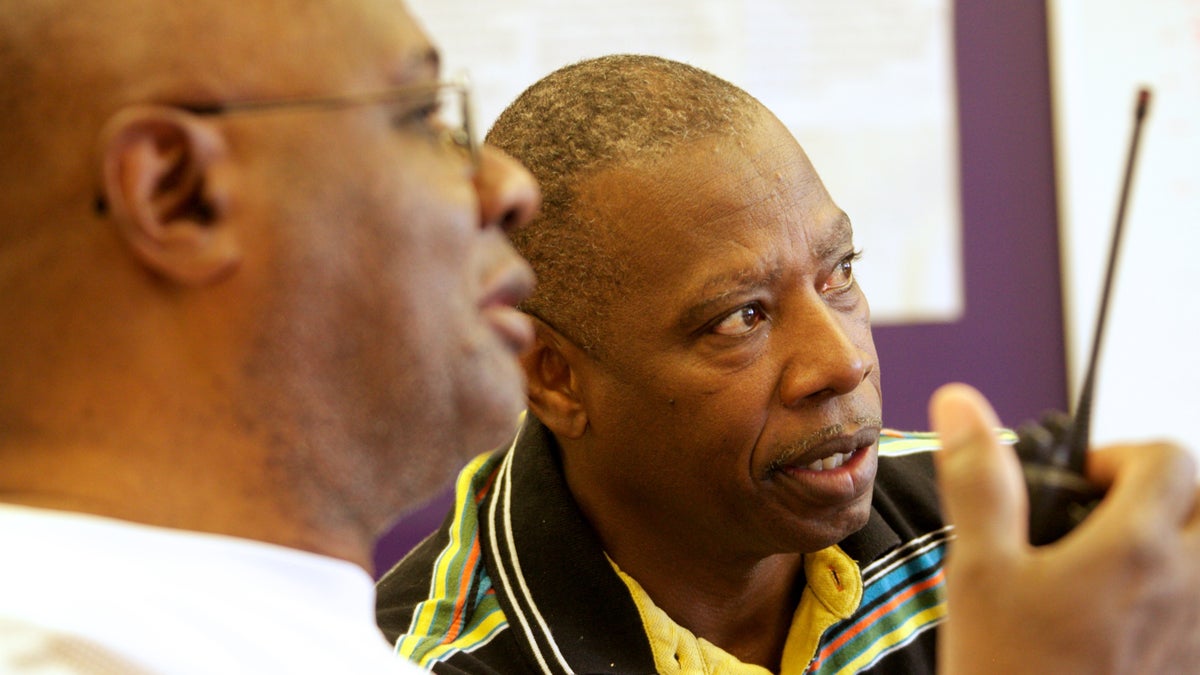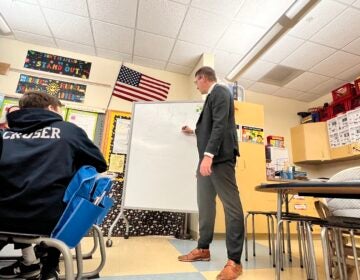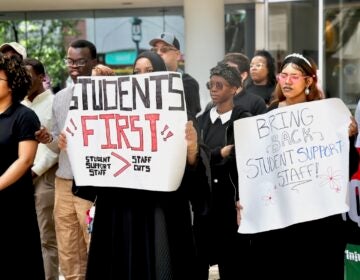Parents question ‘safe routes’ to Philly schools

Some Philly residents, like Russell McCullough and Rev. Chester Williams, have volunteered for patrols as part of the city's WalkSafePHL program for students walking to new schools. (Nathaniel Hamilton/for NewsWorks, file)
Safely steering kids to and from school is never an easy task.
In Philadelphia, there’s an extra challenge this year. As the school district faces an unprecedented financial crisis, about 9,000 of the city’s 134,000 students will be heading to a new school because their former one was closed or consolidated in June.
That means kids will be traversing through unfamiliar neighborhoods, past different intersections and around novel corners.
School district and city officials say they have stepped up their efforts in the wake of 24 schools shutting down. But some parents and teachers are concerned that they are not fully prepared.
As part of an initiative called WalkSafePHL, the district, city government and SEPTA police teamed up to develop new routes that students can take to school. Anthony Murphy, executive director of the city’s Town Watch Integrated Services, said the trips were developed using police and school district data.
“We wanted to make sure we used the most direct route from the closing-school catchment area to the welcoming school,” he said.
In addition, Murphy said that crossing guards, police officers and at least 260 trained volunteers will be on the streets to help get kids to school safely. If trouble arises, he said, volunteers have been told not to intervene and instead call 911.
“The role of the volunteers is to provide that adult presence,” Murphy said. “That will give our children an atmosphere of safety as they’re traveling to and from school.”
Karyn Lynch, chief of the school district’s student support services, added that the routes have been extensively test-run.
“We had interns throughout the summer and professional staff that the city identified that walked each and every one of these routes several times,” she said.
But Lavarr Dixon, a math and science teacher at Warren G. Harding Middle School in the Frankford section, questioned whether volunteers will be able to protect children on their way to school. Harding will be receiving new students from the now-shuttered Carnell Middle Years Annex at Fels.
“However admirable, I don’t think that they have the level of training that is really required to ensure students’ safety,” said Dixon. “I also don’t believe that a volunteer program will be able to sustain the entire year.”
Parent Maurice Jones is worried, too. He is president of the Home and School Association at Lea Elementary School in West Philly, which is taking in new students from the closed-down Alexander Wilson.
For the past four months, Jones said he has been asking the district for a comprehensive safety plan targeted at Lea and Wilson’s merger. As of Friday, he was still waiting, he said.
When asked about Jones’ request, Lynch said that the plan he is seeking is the WalkSafePHL initiative, which is available for viewing at walksafephl.org.
But to Jones, WalkSafePHL and its web site are lacking.
“If you look at the WalkSafePHL plan, it really doesn’t say much. … There’s a map [of a path for students to Lea], and it’s very sketchy. You can see the large streets, but you can’t really read the map very well. And there’s no direction on where people are going to be at, where crossing guards are at.”
Councilwoman Maria Quiñones-Sánchez, who represents the city’s seventh Councilmanic district, said that she did not agree with some of the city’s recommended paths, such as one in her district that steers kids down a small street instead of a larger road nearby with more visibility.
Sánchez also said that information about the new routes has been slow getting to parents.
“Unfortunately, there is so much chaos around funding that there is a lot of confusion,” she said. “As a councilperson, I am not clear about the plan. So I can imagine how my parents feel.”
Sánchez said a safe corridors plan developed for the fourth Councilmanic district by Councilman Curtis Jones, chairman of the public safety committee, should be used as a model for the rest of the city. It utilizes mapping, surveillance cameras and weekly conference calls among principals of nearby schools.
Jones said the WalkSafePHL initiative is “a good first step,” adding, “If they want my playbook, they can have it.”
Murphy defended the city’s plan. “I’m confident that we’ll provide the high level of support and safety that’s needed,” he said.
In addition to trying to make sure that children are secure on their way to school, the district said that it has worked hard to protect kids once they arrive. Each principal has assessed the situation at their school and developed a plan to address any safety concerns they have, Lynch said.
As a result, principals have redeployed safety officers, moved crossing guards to different corners, and sent children from merging schools to Outward Bound trips together, among other things.
These efforts should, in theory, help maintain safety on the streets as well.
But if parents do see something dangerous on the way to school, Murphy said they should alert the police and WalkSafePHL (walksafephl.org, 215-686-1459). If they have concerns about the program’s recommended routes, he said said they should contact WalkSafePHL.
He also encouraged families to be vigilant before and after school hours.
“It takes a village to raise a child,” said Murphy. “So it’s going to take a village to keep children safe.”
WHYY is your source for fact-based, in-depth journalism and information. As a nonprofit organization, we rely on financial support from readers like you. Please give today.




